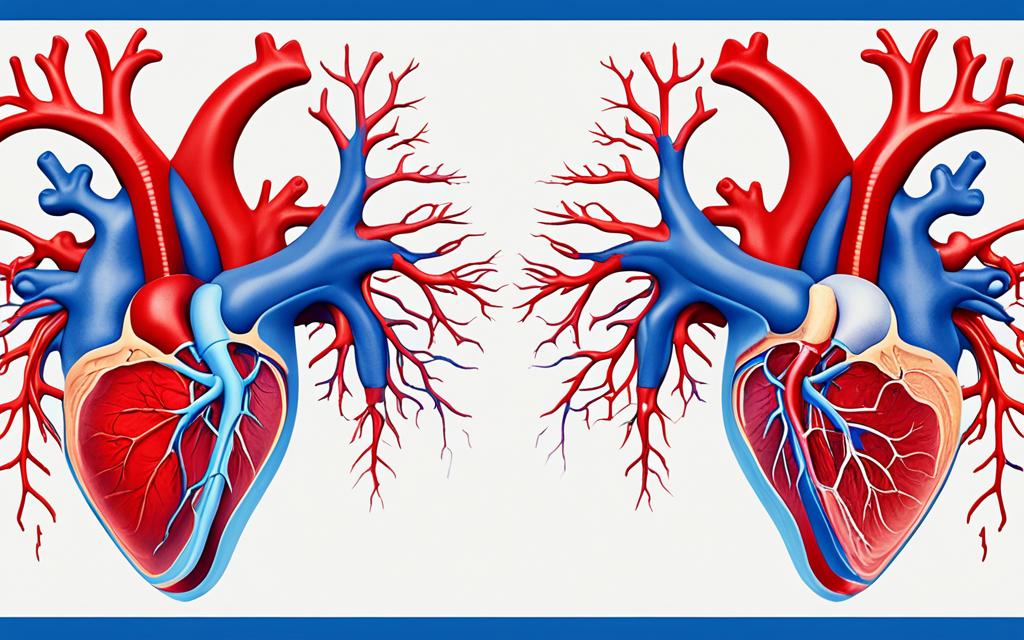Tetralogy of Fallot is a complex congenital heart condition that affects the structure and function of the heart. In this comprehensive guide, you’ll learn about the symptoms, diagnostic procedures, surgical treatment options, and long-term care strategies for managing this condition in your child. Understanding Tetralogy of Fallot and taking proactive steps can help ensure your child receives the best possible care and has the opportunity to lead a healthy, fulfilling life.
Understanding Tetralogy of Fallot
Tetralogy of Fallot is a congenital heart condition that involves four distinct anatomical abnormalities in the heart. These include a ventricular septal defect (VSD), pulmonary valve stenosis, an overriding aorta, and right ventricular hypertrophy. Understanding tetralogy of fallot is crucial, as it can help parents and caregivers recognize the condition and seek the necessary medical care for their child.
What is tetralogy of fallot? It is a complex heart disorder that disrupts the normal development of the heart during fetal growth. The exact causes and risk factors of tetralogy of fallot are not fully understood, but it is believed to be the result of a combination of genetic and environmental factors. While the condition is present at birth, the severity of symptoms can vary greatly from child to child.
| Anatomical Abnormality | Description |
|---|---|
| Ventricular Septal Defect (VSD) | A hole in the wall (septum) between the two lower chambers of the heart, allowing oxygenated and deoxygenated blood to mix. |
| Pulmonary Valve Stenosis | The pulmonary valve, which controls blood flow from the right ventricle to the lungs, is narrowed or obstructed. |
| Overriding Aorta | The aorta, the main artery that carries blood to the body, is positioned directly over the ventricular septal defect, rather than solely over the left ventricle. |
| Right Ventricular Hypertrophy | The right ventricle of the heart becomes thickened and enlarged due to the increased workload caused by the other abnormalities. |
By understanding the complex nature of tetralogy of fallot and the various anatomical abnormalities involved, healthcare providers can develop effective treatment strategies to support children with this condition and help them lead healthy, fulfilling lives.
Symptoms and Diagnosis
Tetralogy of Fallot can cause a range of symptoms of tetralogy of fallot in affected children, depending on the severity of the condition. Common symptoms include cyanosis (bluish discoloration of the skin and lips due to low oxygen levels), difficulty breathing, poor appetite, and delayed growth and development. To accurately diagnose tetralogy of fallot, your child’s healthcare provider will perform a thorough physical examination, order diagnostic tests such as echocardiograms, electrocardiograms, and cardiac catheterization, and may refer you to a pediatric cardiologist for specialized care.
Echocardiograms, which use sound waves to create images of the heart, can help identify the specific structural abnormalities associated with Tetralogy of Fallot. Electrocardiograms (ECGs) measure the electrical activity of the heart and can provide valuable information about the function of the cardiac chambers and valves. Additionally, cardiac catheterization, a minimally invasive procedure, may be necessary to obtain more detailed information about the heart’s anatomy and blood flow.
By working closely with your child’s healthcare team and undergoing the appropriate diagnostic procedures for tetralogy of fallot, you can ensure that Tetralogy of Fallot is accurately diagnosed and that your child receives the tailored treatment and support they need to manage this congenital heart condition effectively.
Surgical Treatments and Outcomes
For children with Tetralogy of Fallot, the primary treatment is surgical intervention to correct the structural abnormalities of the heart. Corrective surgeries, such as the Blalock-Taussig shunt and total correction surgery, aim to improve blood flow, reduce cyanosis, and allow for normal heart function. The timing and success of these surgical treatments for tetralogy of fallot can be influenced by factors like the severity of the condition, the child’s age and overall health, and the expertise of the surgical team.
With advancements in medical technology and surgical techniques, the long-term outlook for children with Tetralogy of Fallot has significantly improved in recent decades. The outcomes of tetralogy of fallot surgery have become more favorable, allowing these individuals to lead active and fulfilling lives.
| Surgical Procedure | Description | Outcomes |
|---|---|---|
| Blalock-Taussig Shunt | This procedure creates a temporary shunt to improve blood flow from the heart to the lungs, typically performed in infancy. | Helps stabilize the child’s condition until they are ready for the total correction surgery. |
| Total Correction Surgery | This comprehensive surgery aims to repair the four structural abnormalities associated with Tetralogy of Fallot, restoring normal heart function. | Significantly improves long-term outcomes, reducing cyanosis and allowing for improved oxygen levels and overall health. |
The expertise of the surgical team and the child’s overall health play a crucial role in determining the outcomes of tetralogy of fallot surgery. With advancements in medical technology and surgical techniques, the prognosis for individuals with Tetralogy of Fallot has greatly improved, offering them the opportunity to lead active, healthy lives.
Tetralogy of Fallot in Early Childhood
Children with tetralogy of fallot may face unique developmental challenges during their early childhood years. These can include delayed growth and development, feeding difficulties, and increased susceptibility to respiratory infections. It is crucial for parents and caregivers to work closely with the child’s healthcare team to address these challenges and provide the necessary supportive care strategies.
One key aspect of supporting a child with tetralogy of fallot in early childhood is ensuring they receive appropriate physical therapy and speech therapy. These specialized interventions can help promote healthy growth and development, improve feeding patterns, and enhance the child’s overall well-being. Additionally, providing specialized nutritional guidance can be instrumental in addressing any feeding difficulties and ensuring the child receives the necessary nutrients for growth and development.
Regular monitoring and close collaboration with the healthcare team are essential to managing tetralogy of fallot in early childhood. This may involve routine check-ups, cardiac imaging, and careful observation of the child’s progress. By working together, parents, caregivers, and medical professionals can ensure the child with tetralogy of fallot receives the comprehensive care and support they need to thrive during this critical developmental stage.
| Developmental Challenges in Early Childhood | Supportive Care Strategies |
|---|---|
| Delayed growth and development | Physical therapy, specialized nutritional guidance |
| Feeding difficulties | Speech therapy, specialized nutritional guidance |
| Increased susceptibility to respiratory infections | Close monitoring, collaborative healthcare team |
Long-Term Care Strategies
Even after successful surgical treatment, individuals with Tetralogy of Fallot will require lifelong ongoing monitoring and follow-up to manage any long-term complications or residual issues. This may include regular check-ups with a pediatric cardiologist, cardiac imaging, and medications to maintain heart health.
As the child grows, the transition to adult care for tetralogy of fallot is a critical step to ensure continuity of care and address any unique needs that may arise during adulthood. The healthcare team will work closely with the patient and their family to facilitate a smooth transition, ensuring the individual receives the appropriate care and support throughout their life.
With the right long-term care strategies for tetralogy of fallot and a dedicated healthcare team, individuals with Tetralogy of Fallot can lead active, fulfilling lives. By prioritizing regular check-ups, medication management, and a seamless transition to adult care, patients can effectively manage their condition and maintain optimal heart health.
Conclusion
Tetralogy of Fallot is a complex congenital heart condition that requires specialized medical care and a comprehensive approach to management. By understanding the condition, recognizing the symptoms, and working closely with healthcare providers, parents and caregivers can ensure their child receives the best possible care and has the opportunity to thrive.
With advancements in surgical techniques and long-term care strategies, the outlook for individuals with Tetralogy of Fallot has significantly improved, allowing them to live active, healthy lives. The dedicated efforts of medical professionals, researchers, and supportive communities have paved the way for better outcomes and a brighter future for those affected by this condition.
As you continue your journey in caring for a child with Tetralogy of Fallot, remember that you are not alone. Lean on the guidance and support of your healthcare team, connect with other families, and remain steadfast in your commitment to your child’s well-being. With the right tools and resources, you can navigate this challenge and empower your child to live a fulfilling life.










